Cool and Satisfying Drawings and Easy Drawings
What you'll learn:
- What to describe: footstep-by-footstep guides.
- How to draw a bird.
- How to draw a dog.
- How to draw a wolf.
- How to draw a horse.
- How to draw a rose.
- How to draw a face.
- How to draw eyes.
- How to draw a nose.
- How to draw a mandala.
- 30 more ideas of things to draw.
- vii drawing techniques for beginners.
- How to keep inspired and motivated.
What to depict: stride-by-step guides.
To help get y'all started, nosotros've selected some simple objects yous can try and sketch. Whether it'southward with pen and newspaper or using Adobe Sketch, nosotros'll run through them footstep-past-step, so you can learn the basics commencement.
Remember, practice makes perfect. You might not nail the detail start time around, so keep trying to get the last drawing right.
Before y'all start, information technology'due south worth downloading a few reference photos of each of the post-obit objects from Adobe Stock. Keep this open in a window on your calculator or tablet, then information technology'll requite you something to mimic with your own cartoon.
How to draw a bird.

one. First by cartoon a big oval or teardrop for the body – if yous choose a teardrop, the point of the shape should confront away from where the head will be.
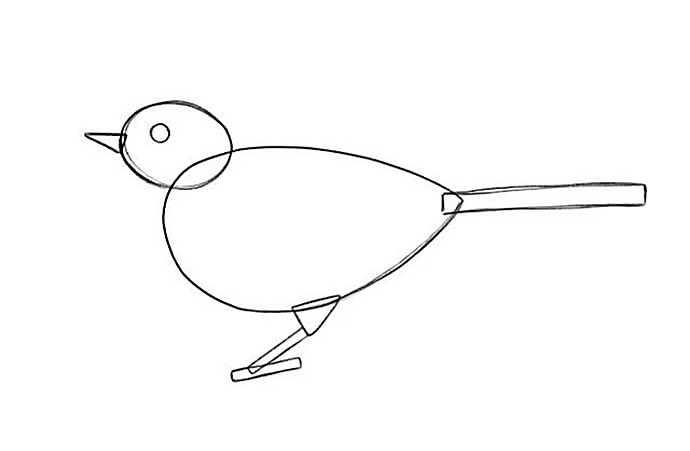
2. Create a circle that is one-half the size of the oval, to describe a bird's head.
3. Split up both of these shapes into quarters.
4. Sketch a couple of curved lines for a neck, to attach the head to the trunk, then add a triangular neb and tail.
5. Sketch downwards from the center point in the oval body to add legs and feet.
6. Add a z-similar shape at the top-left of the oval, to add together shoulders – where you'll draw wings later on.
vii. Utilize your reference photo to add the full outline of the bird and build the body structure from there.
8. Finally, draw in the boosted layers, including wings and lines for feathers. If digital sketching and calculation color, try using the watercolour brushes in Adobe Fresco.
How to draw a dog.
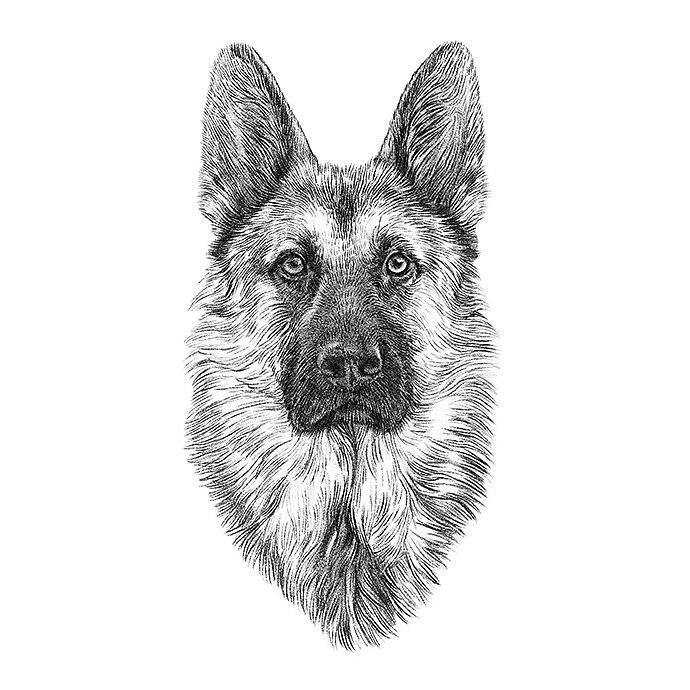
i. If you're cartoon a dog looking face-on, start with an oval shape for its snout.
2. To a higher place this, describe an upside-down u-shape, for the head, so a small oval or triangle for its snout.
iii. Draw the ears next, which volition either flop down the sides of the head in a half-oval shape or point upwardly in a triangle shape.
iv. Inside your upside-down u-shape, draw two spots for eyes and two arches above for eyebrows. Pay close attending to the eyes, capturing these accurately is the key to creating a compelling illustration of a canine.
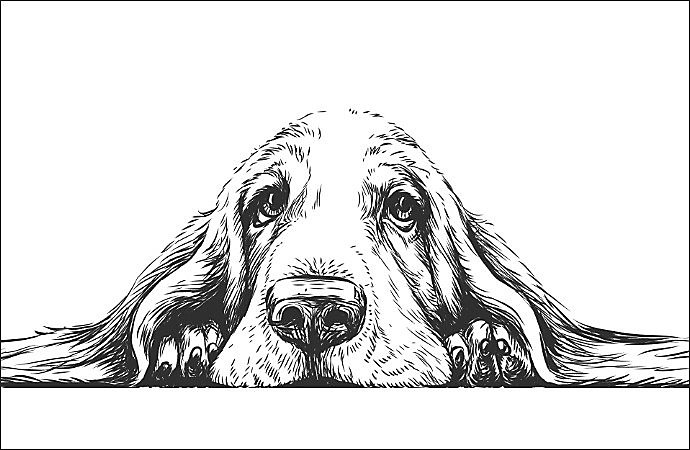
5 From the olfactory organ, draw a line downwards that curves at either side, for the mouth.
6. Add front legs, as they look on your reference photo, then depict a u-shape behind them, to make the body.
7. Finally, sketch two u-shapes either side of the lesser of the body, for back legs, and then add together the tail. Yous can flesh out your drawing in more detail, using the reference photo.
How to draw a wolf.
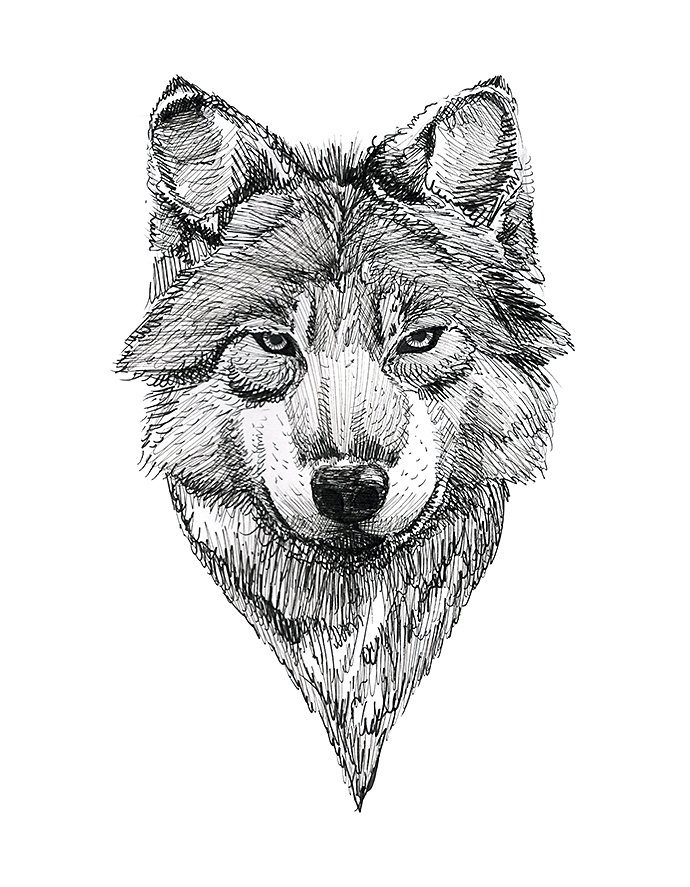
1. This will be a similar composition to sketching a canis familiaris, so follow those steps, but with the post-obit changes.
two. Wolves' faces are slightly leaner, so the wolf you're drawing should have a slightly narrower oval for a snout.
3. When drawing eyes, they need to be closer to the front of the face, too, when you are adding center color, it will generally be lighter.
four. The trunk will be slightly leaner and taller, which means when drawing the u-shape to form it, it needs to be thinner and longer.

5. Legs will besides demand to be lengthier, so draw longer lines when adding them.
6. Wolves' ears are pointier and volition face up upwards, and so you'll demand triangles to form these, close to the tiptop of its caput.
seven. Their fur will exist more rugged when you're sketching out this item.


1. Offset by creating a simple line guide. Draw a slightly curved line for the dorsum leg, an opposing line for the torso, and so add together a guide for the neck and head.
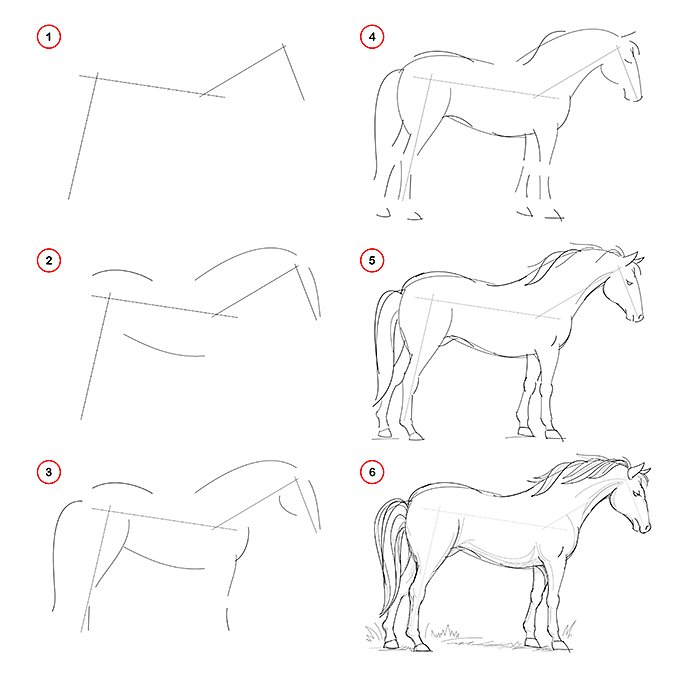
2. Next, add several different semi-circles that will form the horse'due south torso, primary body and upper dorsum legs.
three. Draw ii circles that form the top of the head, and the other a slightly smaller one that will exist for the mouth – and then connect these with lines.
4. Add ears past sketching gently-curved triangles at the top of the caput.
v. Movement onto the legs, which should exist made up of several different circles, which volition reflect the knees and the slightly thicker upper thigh.
6. The forepart legs of a horse will expect different to the dorsum, so study your reference photo to get that shape right.
7. Connect these circles by lines to create the leg outline, then connect your body circles to mimic the body shape of a horse.
8. Add extra layers, drawing the horses' mane, tail and hooves, to consummate the sketch.
How to describe a rose.
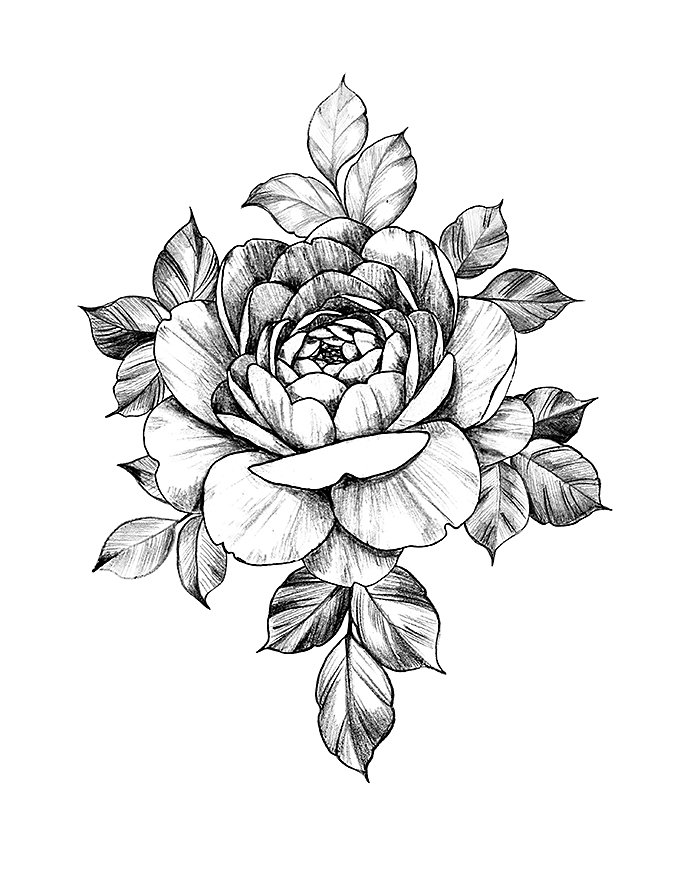
1. Create an open up topped egg-shape in the middle of the folio, as the inner bud of the flower, then add an opening oval at the height.
two. Draw your rose with mini-petals inside this opening oval, then create a heart shape that includes the opening oval inside it.
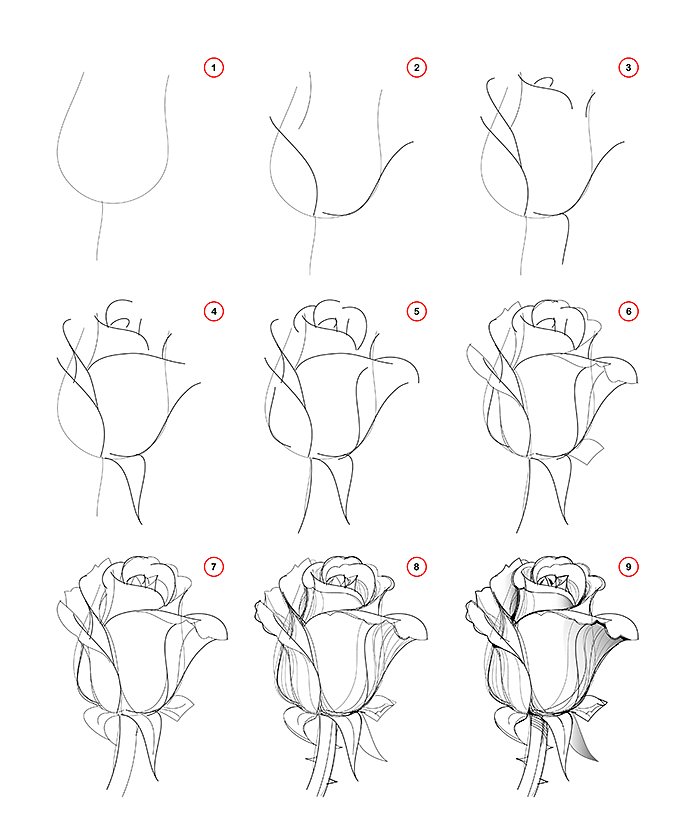
3. Add together another larger heart, to embrace the smaller centre and inner petals each fourth dimension.
4. Repeat this several times, to mimic the appearance of petals opening with each layer.
five. With each layer, outset to add details to the petals, such as the faint lines that display its texture.
6. Sketch a 'loving cup' of petals to go effectually the outside of the inner bud, starting with smaller ones, so eventually make them bigger.
7. Finally, add a stem at the bottom, as a cylinder shape, that connects to the rose – you can include smaller details, such as thorns, to this.
How to draw a face up.
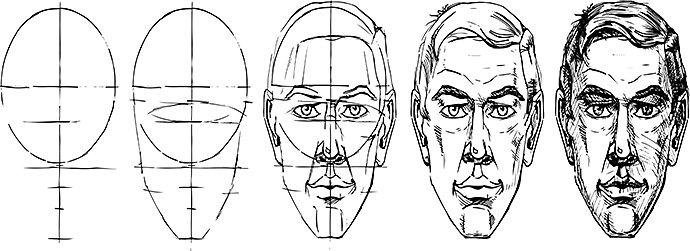
one. Brainstorm your face drawing with a big circle for the upper half of the head, then a horizontal line for the chin and jawline.
2. Draw a vertical line through the middle of the confront and add eight horizontal lines to split the face into unlike portions.
3. On your central line, draw in your eyes, then sketch two vertical lines down from the inner edge of the heart, to the next horizontal line.
iv. In-betwixt these two lines, draw in your nose, according to your reference photo.
5. Just above the optics, add in eyebrows, using a thicker pencil or digital pen.
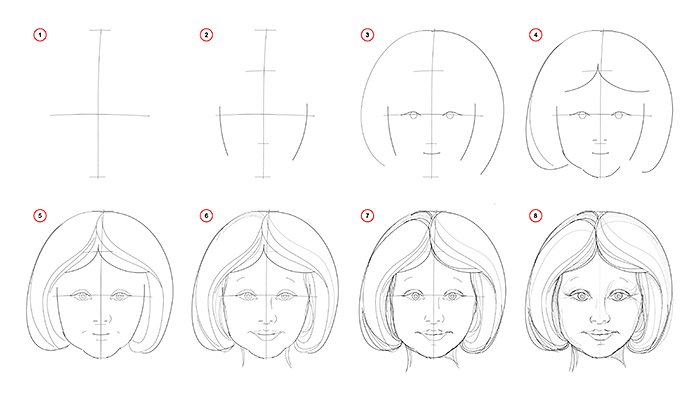
6. Draw a line down from the centre of each eye, towards the horizontal line that is one section below the nose.
seven. From each of the vertical edges of these lines, describe in the lips.
viii. Add in the ears, which should commencement but above your central line and stretch down to the bottom of the nose.
9. Finally, add together detail into the hair, as it appears in your reference image.
How to draw eyes.
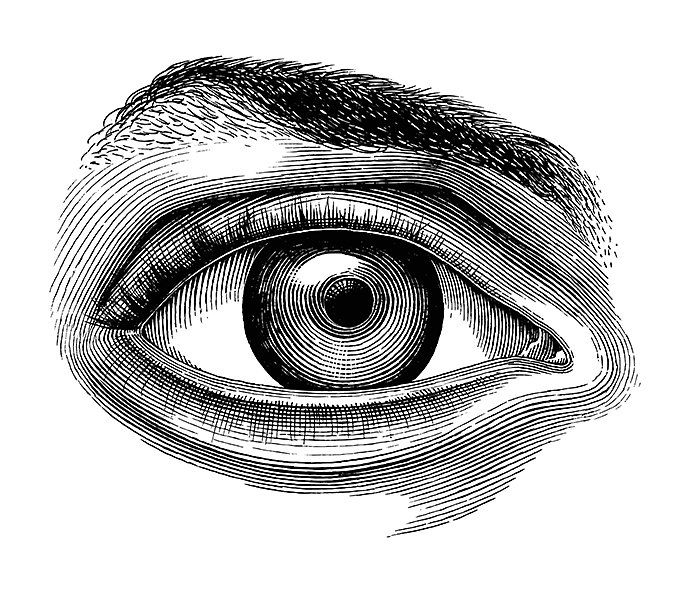
1. Employ the outline of a head, equally detailed in the drawing a confront section, to describe your center, and infinite your eyes i eye-width apart, either side of the nose.
two. Depict a circle for the full eyeball, most of which will be obscured past eyelids.
3. Add a smaller circle in the centre of the eyeball to create the iris, and then an even smaller 1 inside that for the pupils.
4. Sketch curved lines over the eyeball, revealing only the iris.
5. Add actress lines around this for the eyelid folds and tear ducts in the corner of the centre.
6. Finally, add eyelashes on the upper part, starting from the correct edge of the eyelid, and so lower lashes, offset a just below where the lower lid touches the eyeball.
How to describe a nose.

1. Sketch a circle, which will form the ball of the olfactory organ and draw ii slightly curved vertical lines either side of it.
two. Describe a horizontal line into the circle's heart and add two triangle-like shapes either side of the circle, for the nostrils.
iii. Shade a U-shape effectually the circle and vertical lines, to create extra olfactory organ shape.
4. Then, shade in the nostrils, to give a more natural curve to them.
5. Add in 2 mini-circles at the bottom of the nostrils.
six. So draw the olfactory organ how it looks in your reference photos, softening the harder sketch lines you lot drew earlier and shaping it appropriately.
How to draw a mandala.

one. Draw a dot in the centre of your piece of paper, then draw a cross of equal lengths.
2. Add in iii dots on each line. The first should be half an inch from the eye, the 2nd an inch from that and the third i.5 inches from that 1. Repeat this for each line.
iii. Draw another cantankerous, at a 45-degree bending, the same length and with identically spaced dots on it.
4. Connect these dots by drawing three split up circles.
v. Beginning to add fine details – ane thought could exist to draw teardrops, petals and circles to create a symmetrical design.
6. Shade in whatsoever details around those shapes for a colourful mandala drawing design.
30 more ideas of things to describe.
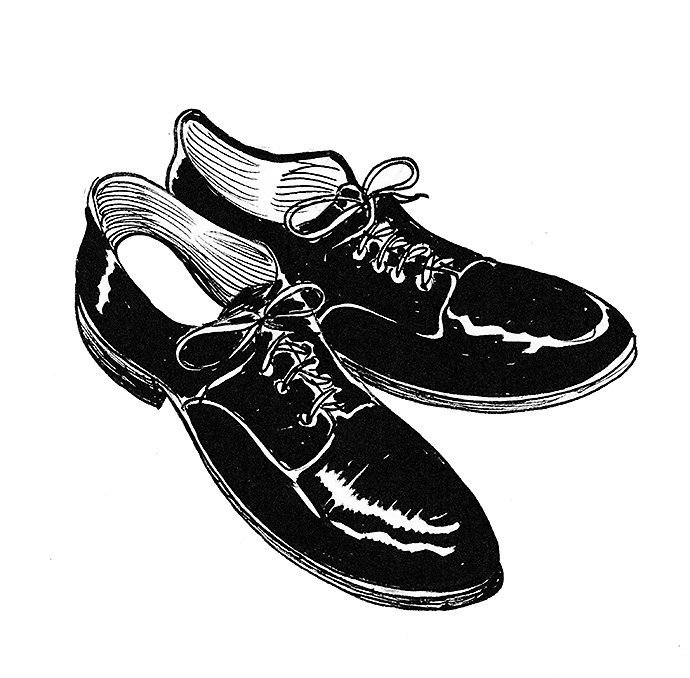
1. Pair of shoes – observe your oldest pair to capture all their creases and wear and tear.
2. Seashell – sketch the unique grooves and details, to have a go at still life drawing.
3. Clouds – tilt your head and showtime experimenting with curved lines in the sky above.
4. Book/album cover – recreate your favourite novel or album encompass.
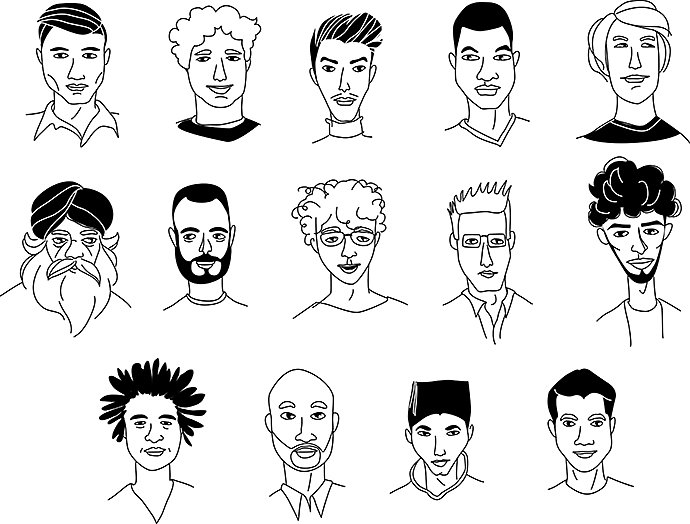
5. Yourself equally a drawing – endeavor a unlike kind of self-portrait to create yourself on-page.
6. Bridge – capture the structure of the span itself, also as the mural surrounding information technology.
seven. Table and chairs – archetype still life, where y'all can focus on nearby objects too.
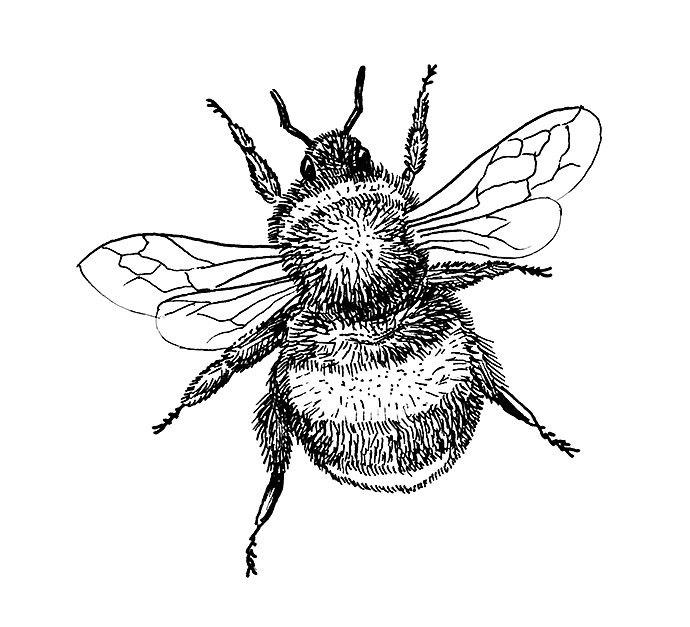
8. An insect – a unique subject, drawing an insect can help you lot go improve at sketching tiny details.
ix. Telly setup – nosotros spend most of our lives in front of our TVs, so why non draw your home setup?
10. Piano – perfect for introducing you to 3D drawing, with tons of detail to capture.
11. Space rocket – capture this crawly construction with all its fine details.
12. The moon – sticking with the space theme, capture its crevices, grooves and shadows.

13. Skull – another fantastic way to get used to sketching shadows – perfect for Halloween-themed compositions.
14. Leaves – whether scattered on the flooring in an autumnal scene or living on a branch.
15. Lightbulb – recreate the bulb itself, simply also the light that shimmers from it.
16. Kitchen – depict however life in your kitchen space, capturing the details of appliances and objects in the infinite.

17. Hands – recreate the lines, marks and creases in your easily, to get used to cartoon the human being course.
xviii. Robot – a mixture of squares and circles, robots can be a fun thing to draw.
xix. Boutonniere of flowers – this volition help you start focusing on the minor details of each petal.
20. Tech around your domicile – this could exist a pair of headphones, a video game controller or Telly remote.
21. Wine bottles – capture both the sleek outline of the bottle and any intriguing labels likewise.

22. Car – caput to your garage to sketch the intricate outlines of your vehicle, along with more frail details of wheels, trims etc.
23. Garden demote – stride into your garden or to your local park to depict a demote and anything surrounding information technology.
24. Firm – while you're exterior, sketch the exterior of your home – windows, doors and all.
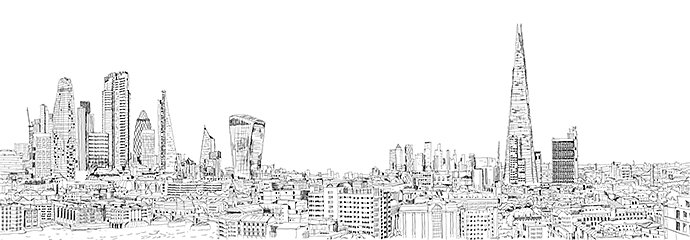
25. City skyline – choice your favourite cityscape and try to emulate its outline – whether during the twenty-four hour period or at dark.
26. Drawing character – choose your favourite character, hit interruption when they're on screen and mimic their advent.
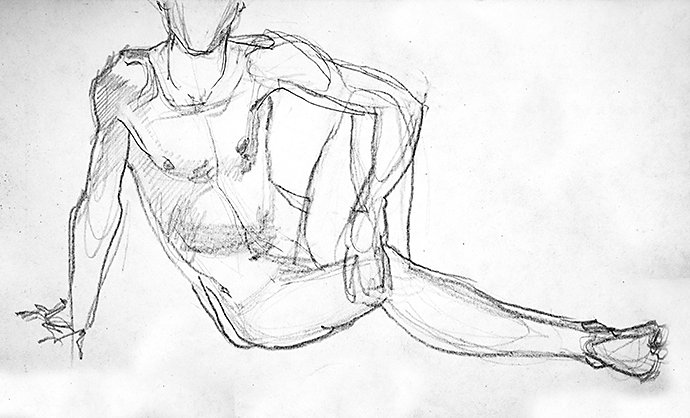
27. Man trunk – when yous're set to try something more than advanced, capture the man form in total.
28. Basin of fruit – gather what you lot take and to focus on an outline first, particular later.
29. Kitchen cupboard – open it up and sketch what'due south inside, it'll get you used to capturing many different-shaped objects.

30. Family pet – if you tin get your cuddly friend to sit however long enough – or take a photograph and use it for reference.
7 drawing techniques for beginners.
Getting your technique just right tin take time if you're learning to draw. But these tips should help you find your own way and refine it over fourth dimension. If y'all're already comfortable with your skills, they'll help you castor up on the fundamentals.
1. Find your cartoon style.
Whatever yous're drawing, whether it'southward your favourite anime character, a blossom in your dorsum garden or houses on a city street, the principles of drawing stay the same.
- Pay attention to shapes – they're building blocks that give a cartoon structure.
- Take your time – don't rush, this will only cause mistakes and add time in the long-run.
- Practice – like anything, you'll only get better by repeating and trying it once again.
Using these rules, you can commencement to refine your own style over fourth dimension. Y'all might find that pointillism is your thing, cartoons are your forte, or line drawings might suit your skills.
ii. Start with basic shapes.
Bones shapes are an essential starting point when drawing any object, especially when turning a 3D object into a 2d drawing.
"You're non but drawing what you lot run into in front of you. Yous're drawing the other side also."
Lucas Elliott, Artist.
To create that depth, interruption downwards whatever yous're drawing into:
· Circles
· Rectangles
· Triangles
You tin can and then smooth these edges out later on, to create a more realistic last prototype. To get this part right, imagine how the figure would look in 3D and from every angle – like information technology would in existent life.
3. Study reference photos.
When you're but starting out, keep a picture of what you lot're drawing in front of y'all. It'll give you something to mimic and help yous better empathize how to draw the outlines and small details of your subject.
"Look at reference images. The more yous learn almost a subject, the better."
Kevin Jay Stanton, Artist
To find a huge drove of imagery, search Adobe Stock for inspiration you can use for your adjacent sketch.
4. Fix rules for yourself.
When you're learning the basics, it can exist tempting to skip to the more advanced stuff. Just it's important to nail the fundamentals first and master a skill first, before moving onto something more complicated.
For instance, as you make full your sketchbook and are experimenting with colours, start with a limited color palette. This will help you figure out how colours piece of work together and won't distract you with all the possibilities out at that place.
"Picking a colour that I honey, and then two more than that wait nice with it really improved my colour sense. When a rule doesn't serve y'all anymore, first to break information technology."
Kevin Jay Stanton, Artist.
5. Follow your passion.
It'due south good to footstep exterior your comfort zone and attempt drawing as many subjects, using different drawing styles, every bit possible. But it's equally as important to find and focus on sketching what you dear.
Cartoon is all about fun. If y'all're interested in drawing manga, for case, try to create equally many of your favourite characters as possible, to expand your skills in that expanse.
"Really pay attention to how they're drawn. You're drawing from someone else'southward sketch, focus on how they build their lines. If creating from real life, pay close attention to the object and the infinite around them."
Lucas Elliott, Artist.
6. For larger compositions, make a grid.
When you graduate from modest sketches and want to create bigger drawings, gridlines are a lifeline. They can help you lot figure out where dissimilar objects vest, equally they appear naturally.
"If y'all have a photo or illustration that's cleaved down into quadrants, yous tin can get-go with one modest section and finish that first. Then, you tin can move onto the next one. Merely makes sure y'all are still connecting it to the previous section, and then they notwithstanding relate to one another."
Lucas Elliott, Artist.
7. Proceed experimenting and evolving your mode.
Here are a few tips on staying inspired and creating new compositions – prepare to fill up your sketchbook with amazing drawings.
- Take a wait at your surroundings. The world is your canvas. Cliched, simply it's truthful. Take a look around your dwelling or enjoy a walk outside and look around you lot – there are subjects you can sketch everywhere.
- Don't be afraid to daydream. When you're not thinking most ideas or forcing yourself to come up with a new composition, inspiration tin sometimes strike. Have a moment to allow thoughts to fill your head and your next creation could arrive.
- Cheque out your contemporaries. A new thought is always influenced by something that has gone before. Look at what other artists are/accept been doing. That includes classical artists, current stars and other beginners, to see what they're creating.
How to keep inspired and motivated.
Here'due south some good advice to help encourage your creativity to run wild and keep you on runway when looking for creative things to draw.
"Focus on a style that you lot're well-nigh intrigued by. If y'all're a beginner, at that place's no shame in copying as much equally possible."
Ethan Young, Graphic Novel Writer and Artist.
"Draw what'south in forepart of y'all. No thing what you do, your deed of trying to capture it will help."
Chris Kindred, Editorial Artist.
"A lot of what people point to with my artwork is faces, simply that used to exist a thing I didn't like drawing. I started doing an exercise where I focused on drawing different facial features and expressions … it definitely helped me."
Mildred Louis, Artist.
"At first, because things don't ever come naturally, it tin can exist discouraging and frustrating. Simply that'south always how information technology goes when you're learning something new. Practise, practice, do, and don't give up."
Jen Bartel, Illustrator and Comic Creative person.
Keep on learning and explore the world of illustration by discovering our illustration tips.
Source: https://www.adobe.com/uk/creativecloud/illustration/discover/easy-things-to-draw.html
0 Response to "Cool and Satisfying Drawings and Easy Drawings"
Post a Comment